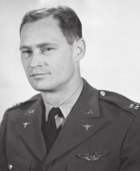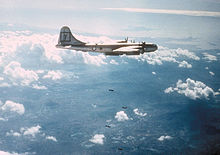John A. Hilger
John Allen Hilger | |
|---|---|
| Battles/wars | World War II Korean War |
| Awards | Silver Star Legion of Merit (4) Distinguished Flying Cross (2) Bronze Star Medal Air Medal (3) |
John Allen Hilger (11 January 1909 – 3 February 1982) was a
Selected by
Early life and career
On January 11, 1909 John Allen Hilger was born in Sherman, Texas. He was one of four sons born to John Frederick and Emma Viola Hilger. He was a graduate of

Hilger embarked on his military career in May 1932 when he became a
By March 1937, Hilger had gone through a divorce and subsequently entered into a new marriage with Virginia Hope Botterud in
World War II
Doolittle Raid
In March 1942, Hilger, now a major, was designated as the deputy commander for the
After the raid, Hilger returned to the United States. On June 27,
Later war service

In September 1942, Hilger promoted to
From July to October 1943, Hilger served in with the
For the last 18 months of World War II, Hilger served in the Western Pacific as a special plans officer on the staff of Admiral
Cold War
Hilger was assigned to Army Air Force headquarters in January 1946. He worked in

During the
In July 1952, Hilger assumed the role of chief in the allocations division within the Directorate of Operations at the Pentagon. He held this position until July 1955 when he was reassigned as the commander of the Air Force Operational Test Center at the Eglin Air Force Base, which was part of the Air Proving Ground Command. In October 1956, he received a promotion to the rank of brigadier general and continued to lead the operational test center until June 1957. Following this, Hilger's next posting sent him to Turkey, where he served as the commander of the U.S. Air Force Group within the Joint U.S. Military Mission for Aid to Turkey, a position he held from June 1957 to June 1959.[2]
From July 1959 to July 1961, he assumed the role of Chief of Staff for Allied Air Forces in
Later life
Following his military retirement, Hilger was employed by the United States Atomic Energy Commission until he fully retired in early 1982. On February 3, 1982, Hilger passed away at the age of 73. In accordance with his wishes, his remains were cremated and his ashes were scattered in the Pacific Ocean, close to the coast of Newport Beach, California.[11]
On November 9, 2001, Hilger and 12 other Doolittle Raiders who were born in Texas were inducted into the
Awards and decorations
During his lengthy career, Hilger earned many decorations, including:[13]

| |||
Command Pilot
| |||||||||||
| Silver Star[13] | Legion of Merit with three bronze oak leaf clusters[13] | ||||||||||
| Distinguished Flying Cross with bronze oak leaf cluster[13] |
Bronze Star Medal | Air Medal with two bronze oak leaf clusters | |||||||||
| American Defense Service Medal with service star |
American Campaign Medal with service star |
campaign star
| |||||||||
Asiatic-Pacific Campaign Medal with four bronze campaign stars |
World War II Victory Medal | National Defense Service Medal with service star | |||||||||
| Korean Service Medal with three bronze campaign stars |
Air Force Longevity Service Award with one silver and two bronze oak leaf clusters |
Republic of China)[14]
| |||||||||
United Nations Korea Medal
|
China War Memorial Medal (Republic of China) |
Korean War Service Medal[N 1] | |||||||||
References
- ^ a b c d Tribe, Henry Franklin. "Hilger, John Allen". Texas State Historical Association. Retrieved April 24, 2022.
- ^ a b c d e f g "Brigadier General John A. Hilger". United States Air Force. Retrieved April 24, 2022.
- ^ Peck. Page 22.
- ^ Woodall. Page 53.
- ^ Woodall. Page 57, 58.
- ^ Zhuang, Pinghui (December 16, 2018). "After the Doolittle Raid: Across the Generations, Second World War Ties that Bind China and the United States". South China Morning Post. Retrieved January 23, 2023.
- ^ Woodall. Page 60.
- ^ a b c d "John A. Hilger". Veteran Tributes. Retrieved April 24, 2022.
- ^ Woodall. Pages 60, 61.
- ^ Woodall. Page 63.
- ^ Woodall. Page 64.
- ^ "Air-Log" (PDF). The History of Aviation Collection (The University of Texas at Dallas). January 2002. Retrieved 2022-10-30.
- ^ a b c d "Valor Awards for John Allen Hilger". Military Times. Retrieved 2023-03-13.
- ^ "Song Meiling with Brigadier General James Doolittle (note Order of the Cloud and Banner 3rd Class) and Colonel John Hilger (note Order of the Cloud and Banner 6th Class), Chongqing, China, 29 Jun 1942". World War II Database. Retrieved 2023-03-13.
- ^ "Republic of Korea Korean War Service Medal". Air Force Personnel Center. Retrieved 2023-01-23.
![]() This article incorporates public domain material from the United States Air Force
This article incorporates public domain material from the United States Air Force
Notes
Bibliography
- Peck Jr., Gaillard R. (2019). Sherman Lead: Flying the F-4D Phantom II in Vietnam (Hardcover). Bloomsbury Publishing. ISBN 9781472829399.
- Woodall, James R. (2015). Twelve Texas Aggie War Heroes: From World War I to Vietnam (Hardcover). Texas A&M University Press. ISBN 9781623493196.
Further reading
- Nelson, Craig (2001). The First Heroes: The Extraordinary Story of the Doolittle Raid—America's First World War II Victory (Hardcover). New York: Viking Penguin. ISBN 9780142003411.
External links
 Media related to John A. Hilger at Wikimedia Commons
Media related to John A. Hilger at Wikimedia Commons
